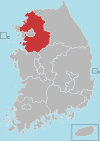Municipal City in Gyeonggi Province, South Korea
Dongducheon (Korean: 동두천; Korean pronunciation: [ˈto̞ŋ.du.tɕʰʌ̹n]) is a city in Gyeonggi Province, South Korea.
The city, to the north of Seoul, is strategically important for the defense of the Korean capital. The main camps of the United States Second Infantry Division are in the city, and the division command is at Uijeongbu.
History
Under Goguryeo, the dynasty's territory extended southward into Korean peninsula, and Dongducheon became part of the kingdom in the form of naeulmae hyun (a certain form of ancient village land holding). Later Dongducheon became Sacheon village of Unified Silla in the North-South States Period. It was part of the district of Yangju in Goryeo.[1]
Modern
In 1963, its status was raised to that of a township, Tongduchon (eup). In 1981, Dongducheon City was established, encompassing Yangju county.
Climate
Dongducheon has a monsoon-influenced humid continental climate (Köppen: Dwa) with cold, dry winters and hot, rainy summers.
| Climate data for Dongducheon (1999–2020 normals, extremes 1998–present)
|
| Month
|
Jan
|
Feb
|
Mar
|
Apr
|
May
|
Jun
|
Jul
|
Aug
|
Sep
|
Oct
|
Nov
|
Dec
|
Year
|
| Record high °C (°F)
|
15.0
(59.0)
|
19.8
(67.6)
|
24.7
(76.5)
|
31.0
(87.8)
|
33.4
(92.1)
|
35.5
(95.9)
|
36.2
(97.2)
|
38.7
(101.7)
|
33.2
(91.8)
|
29.7
(85.5)
|
26.2
(79.2)
|
16.3
(61.3)
|
38.7
(101.7)
|
| Mean daily maximum °C (°F)
|
2.4
(36.3)
|
5.8
(42.4)
|
12.1
(53.8)
|
19.0
(66.2)
|
24.5
(76.1)
|
28.2
(82.8)
|
29.0
(84.2)
|
30.1
(86.2)
|
26.3
(79.3)
|
20.5
(68.9)
|
12.2
(54.0)
|
3.9
(39.0)
|
17.8
(64.0)
|
| Daily mean °C (°F)
|
−3.8
(25.2)
|
−0.8
(30.6)
|
5.0
(41.0)
|
11.6
(52.9)
|
17.4
(63.3)
|
21.8
(71.2)
|
24.3
(75.7)
|
24.9
(76.8)
|
20.1
(68.2)
|
13.1
(55.6)
|
5.7
(42.3)
|
−1.9
(28.6)
|
11.5
(52.7)
|
| Mean daily minimum °C (°F)
|
−9.0
(15.8)
|
−6.2
(20.8)
|
−0.8
(30.6)
|
5.2
(41.4)
|
11.3
(52.3)
|
16.7
(62.1)
|
20.9
(69.6)
|
21.2
(70.2)
|
15.3
(59.5)
|
7.4
(45.3)
|
0.5
(32.9)
|
−6.9
(19.6)
|
6.3
(43.3)
|
| Record low °C (°F)
|
−26.2
(−15.2)
|
−19.7
(−3.5)
|
−10.7
(12.7)
|
−4.7
(23.5)
|
2.6
(36.7)
|
8.0
(46.4)
|
15.3
(59.5)
|
12.1
(53.8)
|
4.4
(39.9)
|
−4.7
(23.5)
|
−10.1
(13.8)
|
−18.0
(−0.4)
|
−26.2
(−15.2)
|
| Average precipitation mm (inches)
|
18.4
(0.72)
|
26.0
(1.02)
|
32.0
(1.26)
|
73.2
(2.88)
|
95.2
(3.75)
|
130.5
(5.14)
|
431.7
(17.00)
|
347.5
(13.68)
|
137.9
(5.43)
|
55.1
(2.17)
|
47.4
(1.87)
|
22.2
(0.87)
|
1,417.1
(55.79)
|
| Average precipitation days (≥ 0.1 mm)
|
5.2
|
5.3
|
7.2
|
9.0
|
9.0
|
10.3
|
16.8
|
14.8
|
8.4
|
6.5
|
8.3
|
7.6
|
108.4
|
| Average snowy days
|
7.1
|
5.3
|
3.6
|
0.1
|
0.0
|
0.0
|
0.0
|
0.0
|
0.0
|
0.0
|
2.0
|
6.6
|
24.6
|
| Average relative humidity (%)
|
60.9
|
57.5
|
55.3
|
55.3
|
62.3
|
68.4
|
79.5
|
77.8
|
73.6
|
69.3
|
64.9
|
62.4
|
65.6
|
| Mean monthly sunshine hours
|
183.7
|
180.8
|
209.6
|
206.0
|
231.2
|
203.9
|
128.7
|
164.1
|
182.4
|
201.2
|
160.6
|
169.6
|
2,221.8
|
| Percent possible sunshine
|
57.3
|
56.4
|
51.1
|
48.9
|
47.1
|
41.0
|
24.3
|
35.4
|
43.7
|
53.8
|
52.3
|
54.8
|
46.0
|
| Source: Korea Meteorological Administration (snow and percent sunshine 1981–2010)[2][3][4]
|
Festivals
Since 1999, Dongducheon has annually hosted the Dongducheon Rock Festival, one of the biggest rock festivals in South Korea. In 2007, the festival was held at Camp Nimble, a former US Army installation returned to South Korea.
A maple festival is held every autumn in several streets and parts of the city.
Education
There are 10 high schools, 15 middle schools, 38 elementary schools, and Hanbuk University.




